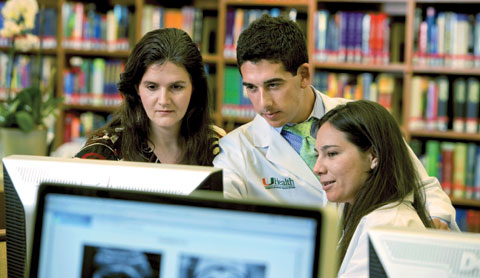Q: Best Clinical Solution?
A: Evidence-Based Medicine
By Joslyn M. Cassano | Photos by Richard Patterson
Evidence-based medicine, which determines the best clinical care based on research findings and the patient’s individual needs, is being instilled into the culture of the Miller School and UHealth.
 |
| Reviewing the details of a patient case are, from left, residents Lauren Peirce Carcas, M.D., and Adriana Arcila, M.D.; chief resident Alina Khan-Ghany, M.D.; Sheri Keitz, M.D., Ph.D., chief of medicine at the Miami VA and associate dean for faculty diversity and development; and resident Shahab Hyder, M.D. |
Every morning a group of nine internal medicine residents on rotation at the Miami VA Medical Center gather to listen to one of their peers discuss the details of a case recently encountered on the wards. The informal presentation always starts with the patient and works toward a solution related to their care.
During these presentations, the residents explain their initial assessment of the problem (e.g., patient presenting with a swollen knee), share a clinical question it posed (e.g., based on history and clinical exam, does this patient have a septic joint?), and outline the steps taken to arrive at an answer that is based on the best evidence.
This exercise is part of their training in evidence-based medicine (EBM), a practice that has a long history but did not emerge as a term in medical literature until 1992. Now, EBM, a method for physicians to inform clinical care based on the individual needs of the patient and the best research available, is regarded as a crucial component in any reform of American health care. In his June address to the American Medical Association, President Barack Obama said we need to “figure out what works and encourage rapid implementation of what works into your practices ... We need to encourage a broader use of evidence-based guidelines.”
The basic premise of EBM—to incorporate best evidence into clinical care—may sound intuitive, but in reality many physicians have not been taught the skills to delve into medical literature. With thousands of medical journals and hundreds of thousands of studies available for searching, students and physicians need to learn what questions to ask and the best, most efficient way to find the answer.
With the arrival in 2007 of EBM expert and advocate Sheri Keitz, M.D., Ph.D., associate dean for faculty diversity and development at the Miller School and chief of medicine at the Miami VA Medical Center, new efforts were initiated to bolster existing EBM training and practice so that they are hardwired into the culture of UHealth, the University of Miami Health System.
In addition to the daily presentations, some residents rotating through the outpatient clinics do one academic half-day session per month on EBM, first training with faculty at the Miller School’s Louis Calder Memorial Library to learn how to access and navigate the VA network from campus and at home, then with
a faculty member who has been EBM-trained. By implementing these practices, Keitz hopes to inspire a sea change across the medical campus whereby evidence-based practice becomes a natural part of how residents and physicians care for patients.
“Evidence-based medicine is not meant to be an ivory tower effort or a research project,” says Alina Khan-Ghany, M.D., chief resident at the VA.
“It should be quick, efficient, and completely integrated into how patients are cared for.”
Khan-Ghany mentors residents, helping them prepare for their presentations and fielding questions related to EBM as they arise on the wards. “EBM has always been encouraged at the VA, but is not a structured part of the residency program,” she says. “This is the biggest change Dr. Keitz has made. Now it informs part of the curriculum at the VA.”
Keitz believes training residents in EBM is a critical first step to the implementation of the discipline across campus. “Residents are on the front line of patient care, and they struggle with critical questions every day,” says Keitz, who co-developed a national curriculum for teaching EBM. “They need and want to know the best answers. We’re creating an environment for residents to be taught and a need for attendings to follow suit.”
The staff at the Calder Memorial Library, led by executive director Mary Moore, Ph.D., are also heavily involved in EBM, particularly as it applies to introducing research methods to medical students.
“We want to help our students and physicians practice medicine based on the most up-to-date, highest quality, most reliable evidence,” says Moore, who is working with others to create a Center for Informed Medical Decisions in the library that will focus on promoting and sustaining evidence-based methods.
 |
Librarian Tanya Feddern-Bekcan, M.O.T., M.L.I.S.,
left, assists students Matthew Salzberg and Valentina Rodriguez on a medical literature search. |
EBM at the Miller School
As one of the early subscribers to the EBM movement, Mark O’Connell, M.D., senior associate dean for medical education, attributes its evolution to the development of randomized clinical trials beginning in the 1960s, combined with the introduction of computer databases and search tools in the 1980s.
“The goal of the whole movement is to make it
so that students in the earliest part of their learning as physicians develop a behavior such that every time they are taking care of patients, their brain is posing the question: ‘What do I need to know to make sure this is the best outcome for this patient?’” says O’Connell.
“We have to train future doctors so that they cannot stand not to know something, then train them how to get that information in a snap, how to recognize good from bad information, and how to get patients to behave in the way the evidence says they need to behave in order to get the best outcome.”
In the late 1980s the University became one of the first in the country to implement EBM in the medical curriculum as part of the internal medicine clerkship and offer it as an elective for seniors.
When the medical curriculum was overhauled in 1998, EBM was integrated into the generalist primary care clerkship.
First- and second-year students are trained in the foundations of EBM, including literature searching, with the help of the staff at Calder. But there have been some obstacles to keeping EBM in the curriculum in the latter years as it was originally intended. EBM was moved to and then phased out of the primary-care clerkship in the third year, and more significantly, it has not been consistently role modeled in clinical settings.
O’Connell is revisiting how to best integrate EBM into the curriculum and to ensure it receives greater emphasis in clinical clerkships.
O’Connell sees EBM’s primary value in its ability to help doctors sift through vast amounts of information available to them. “During a practitioner’s career, the knowledge base of medicine will double countless times,” he says. “For example, you can never keep up on the number of articles published on liver disease every year. If you started reading one article on liver disease right now and read one every day, you’d be about a century behind in ten years.”
The Strength of a Study
Perhaps the most important thing to understand about the importance of EBM is that not all studies are created equal. Keitz points to a recent article,
“The ADVANTAGE Seeding Trial: A Review of Internal Documents,” in the journal the Annals of Internal Medicine.
The article concluded that the 2003 ADVANTAGE study, which looked at the differences between the arthritis medications Vioxx and Naproxen (released in the same journal), was actually a “seeding trial.” A “seeding trial” is a study conducted by a pharmaceutical company designed to look as though it’s answering a scientific question, when it is primarily fulfilling a marketing objective.
The ADVANTAGE study, conducted by Vioxx maker Merck & Co., was presented as a comparison of the “gastrointestinal tolerability” of the two drugs. However, as the recent article discussed, Merck’s internal documents and court paperwork revealed the trial was developed by Merck’s marketing division to create positive perceptions about the drug.
The marketing strategy was effective. Before its release, 5,557 participants received Vioxx and 600 investigators prescribed it, leading to positive media exposure and an upturn in prescribing patterns.
A goal of EBM is to prepare physicians to think about studies critically and hesitate before taking them at face value. At the very least, doctors who are going regularly to the literature will stay informed when deceptive practices are uncovered or when new studies contradict old findings.
“Journals like to publish splashy results,” says Keitz. “Unfortunately, the peer-review journal system can be corrupted, and you have to find a way to assess the
validity of what you are reading.”
Study results can also contain method flaws that make the conclusions weak. EBM teaches physicians how to critically review methods to determine if the
study’s summary and conclusion are reliable and if they
are applicable to the patient in their care.
“There are competencies and skills a person has
to have to identify a clinical question in real time and to know where to look for the answer,” says Keitz.
Central to teaching these skills are the “5 As” of the evidence cycle: Assess, Ask, Acquire, Appraise, and Apply. Physicians and medical students are asked to determine the relevant clinical question, obtain evidence from an appropriate source, examine the evidence for its worth and reliability, and apply the evidence to the patient’s values and circumstances. Inherent in the process is development of good judgment, including whether and how to generalize the study results to your patient’s circumstance.
Theory and Practice
Keitz stresses that EBM is not in opposition to clinical expertise. “Expert opinion is a critically important form
of evidence,” she says. “EBM complements clinical experience by teaching people not to be afraid of uncertainty and to get excited about asking questions.”
Even the most practiced doctors can find themselves in new situations. When she was still new in her position at the Miami VA, Keitz encountered her first case of dengue fever in one of the VA’s patients. To determine
the best course of action, the team relied on a combina-tion of advice from infectious disease colleagues and their own reading.
“The reason we do EBM is to impact patient care,” says Khan-Ghany. “I think of it as a skill. Just as you learn how to do invasive procedures, residents are being taught how to critically appraise articles and objectively evaluate the evidence, with the ultimate goal of better patient care. It’s not abstract learning.”
|


